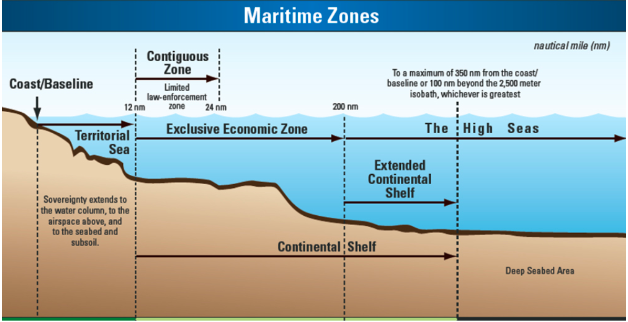Context:
The Supreme Court of India has given permission to fishermen using purse seine fishing gear to fish beyond territorial waters (12 nautical miles) and within the Exclusive Economic Zone (EEZ) (200 nautical miles) of Tamil Nadu, with restrictions.
| Probable Question:
Q. Discuss the significance of the Supreme Court’s decision and its potential implications on the fishing industry and the marine ecosystem of India. |

Image Source: usgs.gov
About Exclusive Economic Zone(EEZ):
- The 1982 United Nations Convention on the Law of the Sea (UNCLOS) defines an Exclusive Economic Zone(EEZ).
- It is an area that shall not extend beyond 200 nautical miles from the baselines.
- The EEZ is measured from the breadth of the territorial sea.
- Access to the zone by foreign fleets is also solely within the coastal state’s discretion and subject to its laws and regulations.
- India’s Definition of EEZ:
- India has legally defined the concept of EEZ in its “Territorial Waters, Continental Shelf, Exclusive Economic Zone and Other Maritime Zones Act, 1976”.
- According to the Act, the EEZ of India is an area beyond and adjacent to the territorial waters. The limit of such a zone is two hundred nautical miles from the baseline.
Multilateral and Regional Conventions:
-
- Under Articles 56.1(a) and 56.1(b)(iii) of UNCLOS, coastal states have sovereign rights to ensure that the living and non living resources of the EEZ are used, conserved and managed, and not subject to overexploitation.
- In order to prevent overexploitation, coastal States must determine the total allowable catch (TAC) in the EEZ.
- Convention for the Conservation of Southern Bluefin Tuna 1993 (SBT) could have also been referred to by the top court to enable recovery of depleted fishing stocks.
-
- The crux of the SBT is TAC and distribution of allocations among the parties to the SBT, which are very relevant from the angle of conservation of general fishery.
- TAC and the catch quotas are aimed at putting sustainable use into practice among fishermen and maintaining maximum sustainable yield (MSY).
- Regulation of fishing methods
-
- Tarawa Declaration of the South Pacific Forum: It prohibits the use of large drift nets that allows maximum catch for the purse seiners, in turn leaving behind insufficient catch for traditional fishermen.
- The 1989 Convention for the Prohibition of Fishing with Long Drift Nets in the South Pacific goes as far as to restrict port access for drift net fishing vessels.
- The United Nations General Assembly passed Resolutions 44/225 (1989) and 46/215 (1991) supported and strengthened this development, calling for a moratorium on all largescale pelagic drift net fishing vessels in high seas.
- Although the conventions and the UN General Assembly resolutions are applicable to the state parties in the high seas, these are relevant in terms of preventing overfishing in general and the conservation of fishery management in the EEZ as well.
- Non-selective fishing technology:
-
- Fishing regulations need to look into nonselective fishing methods like turtle excluder fishing gear.
- It can prevent the bycatch of other marine living species (which could include, many a times, endangered species) — a potential ground for trade embargo.
Current Status of Indian Fisheries
- Fisheries are the primary source of livelihood for several communities.
- India is the world’s second-largest fish producer with exports worth more than Rs 47,000 crore.
- Fisheries are the country’s single-largest agriculture export, with a growth rate of 6 to 10 per cent in the past five years.
Issue with Court’s Recent Order:
- It is more concerned about regulating fishing with administrative and transparency measures than about the conservation measures and obligations which a coastal state owes in its EEZ under the United Nations Convention on the Law of the Sea (UNCLOS).
- The top court should seek guidance from the obligations arising from the multilateral and regional conventions which are meant to bring in sustainable fishing practices.
Conclusion
- Despite the best conservation measures and regulation of fishing methods adopted by the authorities, it will be a challenge in dealing with the limitless character of the seas which renders a common resource such as fish available for exploitation by all.
- The theory of Garrett Hardin, ‘The Tragedy of the Commons’, which says ‘Freedom in a commons brings ruin to all’ should convince all fishermen that they must cooperate in complying with conservation measures.
About UNCLOS:
- The United Nations Convention on the Law of the Sea (UNCLOS), 1982 is an international agreement that establishes the legal framework for marine and maritime activities.
- It is also known as Law of the Sea. It divides marine areas into five main zones namely- Internal Waters, Territorial Sea, Contiguous Zone, Exclusive Economic Zone (EEZ) and the High Seas.
- It is the only international convention which stipulates a framework for state jurisdiction in maritime spaces. It provides a different legal status to different maritime zones.
- It provides the backbone for offshore governance by coastal states and those navigating the oceans.
- It not only zones coastal states’ offshore areas but also provides specific guidance for states’ rights and responsibilities in the five concentric zones.
|
News Source: The Hindu
![]() 17 Feb 2023
17 Feb 2023

